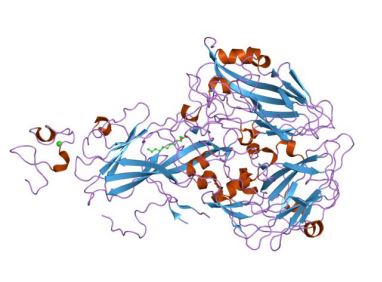Very low-density lipoprotein receptor (VLDLR) is a member of the low-density lipoprotein receptor (LDLR) family. By opposition to LDLR, VLDLR is highly expressed in adipose tissue, heart, skeletal muscles, and endothelial cells of capillaries and small arterioles but is virtually absent in the liver. Its expression is directly regulated by PPAR-γ. Structurally, VLDLR contains an extracellular N-terminal ligand-binding domain with eight cysteine-rich LDLR type A repeat domains, an epidermal growth factor, an O-linked glycosylation sugar domain, a single transmembrane sequence, a single transmembrane sequence, and a cytoplasmic domain which contains an NPxY sequence. In humans, this receptor is encoded by the VLDLR gene located on locus 9p24 on chromosome 9. VLDLR can bind to ligands containing apolipoprotein E (apoE), thereby playing multifunctional functions.
| Basic Information of VLDLR | |
| Protein Name | Very low-density lipoprotein receptor |
| Gene Name | VLDLR |
| Aliases | VLDL-R, VLDL receptor |
| Organism | Homo sapiens (Human) |
| UniProt ID | P98155 |
| Transmembrane Times | 1 |
| Length (aa) | 873 |
| Sequence | MGTSALWALWLLLALCWAPRESGATGTGRKAKCEPSQFQCTNGRCITLLWKCDGDEDCVDGSDEKNCVKKTCAESDFVCNNGQCVPSRWKCDGDPDCEDGSDESPEQCHMRTCRIHEISCGAHSTQCIPVSWRCDGENDCDSGEDEENCGNITCSPDEFTCSSGRCISRNFVCNGQDDCSDGSDELDCAPPTCGAHEFQCSTSSCIPISWVCDDDADCSDQSDESLEQCGRQPVIHTKCPASEIQCGSGECIHKKWRCDGDPDCKDGSDEVNCPSRTCRPDQFECEDGSCIHGSRQCNGIRDCVDGSDEVNCKNVNQCLGPGKFKCRSGECIDISKVCNQEQDCRDWSDEPLKECHINECLVNNGGCSHICKDLVIGYECDCAAGFELIDRKTCGDIDECQNPGICSQICINLKGGYKCECSRGYQMDLATGVCKAVGKEPSLIFTNRRDIRKIGLERKEYIQLVEQLRNTVALDADIAAQKLFWADLSQKAIFSASIDDKVGRHVKMIDNVYNPAAIAVDWVYKTIYWTDAASKTISVATLDGTKRKFLFNSDLREPASIAVDPLSGFVYWSDWGEPAKIEKAGMNGFDRRPLVTADIQWPNGITLDLIKSRLYWLDSKLHMLSSVDLNGQDRRIVLKSLEFLAHPLALTIFEDRVYWIDGENEAVYGANKFTGSELATLVNNLNDAQDIIVYHELVQPSGKNWCEEDMENGGCEYLCLPAPQINDHSPKYTCSCPSGYNVEENGRDCQSTATTVTYSETKDTNTTEISATSGLVPGGINVTTAVSEVSVPPKGTSAAWAILPLLLLVMAAVGGYLMWRNWQHKNMKSMNFDNPVYLKTTEEDLSIDIGRHSASVGHTYPAISVVSTDDDLA |
VLDLR plays a critical role in lipid uptake and metabolism of apoE-containing triacylglycerol(GC)-rich lipoproteins. In the brain, VLDLR is a key component of the reelin pathway, thereby functioning in neuronal migration. Mutations with the VLDLR gene lead to various disorders of varying severities such as type I lissencephaly, VLDR-associated cerebellar hypoplasia, and atherosclerosis. Besides, studies have suggested that VLDLR may play a critical role in tumor development by affecting cell proliferation and metastasis. Additionally, implementation of VLDLR into the liver may be a promising therapy for familial hypercholesterolemia (FH). Moreover, VLDLR seems to be linked to obesity, because its deficiency protects mice from obesity. In agreement with the results in mice, patients with VLDLR mutations have abnormally low body mass index compared with control subjects.

This study investigated the role of VLDLR in adipose tissue inflammation and adipocyte-macrophage interactions in both wild-type and VLDLR-deficient mice fed a high-fat diet. The results showed that this receptor contributed to adipose tissue inflammation and mediated adipocyte-macrophage interaction.
Using CD81-deficient Huh7.5 cells, this study identified VLDLR as an HCV receptor independent of canonical CD81-mediated HCV entry.
This study investigated the distribution patterns of VLDLR variants among different chicken breeds and their relationship to egg production. The results supported the conclusion that VLDLR served as a candidate gene for modulating egg production.
This study investigated the expression of VLDLR in colorectal cancer (CRC) patients and the effect of VLDLR overexpression on CRC cell proliferation and migration. Besides, the expression relationship between miR-200c and VLDLR was studied. The results suggested that VLDLR downregulation mediated by increased expression of miR-200c may contribute to the development of CRC.
This study reported the treatment of mice with fenofibrate, a PPARα agonist and widely used triglyceride (TG)-lowering drug for treatment of dyslipidemia, markedly upregulated hepatic VLDLR, which played major roles in TG metabolism.
Preparation of membrane proteins with high yield and appropriate bioactivity is a prerequisite for their structural and functional studies. We now offer specialized membrane protein preparation services based on our advanced Magic™ Membrane Protein Production Platform. We employ both traditional and novel techniques to solubilize, reconstitute, and incorporate your protein of interest into systems such as detergent micelles, liposomes, nanodiscs, and polymers. We have gained extensive experience in selecting the most suitable formats and optimizing the solubilized conditions that can maximally keep their structural and functional integrity. Besides, aided by our versatile Magic™ anti-membrane protein antibody discovery platform, we also provide customized anti-VLDLR antibody development services.
Here, Creative Biolabs works as a first-class producer in the biological market that has successfully achieved quantities of membrane protein preparations. We are proud to introduce our one-stop, self-identity services for specific proteins as clients’ requirements. Contact us to discuss your project requirements and experience the great value of our expert services.
All listed services and products are For Research Use Only. Do Not use in any diagnostic or therapeutic applications.